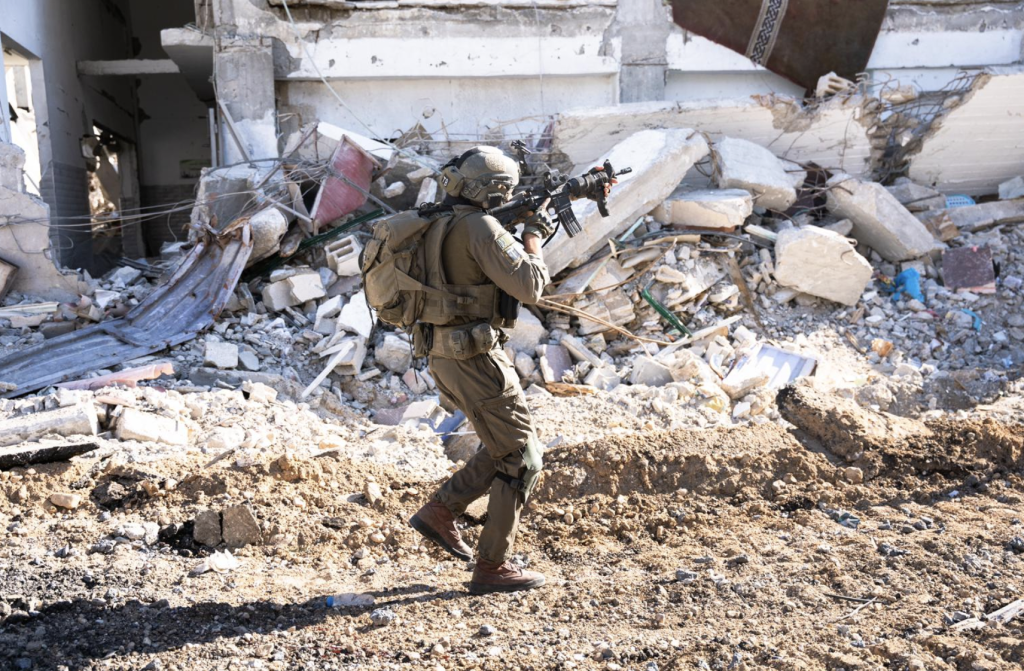
While much focus in Gaza has been on the IDF operation around Shifa hospital, Israeli units have continued to carry out raids in the southern Gaza city of Khan Younis. This is important because it illustrates a two-pronged approach to keeping Hamas and Palestinian Islamic Jihad terrorists off-balance and checked in Gaza. It also represents a new phase of fighting which involves utilizing relatively small units in raids that are designed to keep terrorists on the run.
Gaza is divided into two sections — north and south — by the Netzarim corridor, a route of several miles south of Gaza City that provides the IDF easy access to routes into Gaza City and to central Gaza. It is from this corridor that the IDF launched the Shifa hospital raid on the evening of March 17, arriving by surprise and capturing hundreds of suspected terrorists.
In southern Gaza, the IDF is continuing to operate in Khan Younis amid discussions about how the IDF will eventually operate in the southern Gaza city of Rafah on the Egyptian border. Although Hamas has thousands of armed men in Rafah and an estimated four battalions of fighters, it has not tried to infiltrate Khan Younis or carry out large attacks. Instead, Hamas members continue to hide out in and around Khan Younis. The IDF confronts threats using mostly the special forces of the Commando Brigade. For example, the Maglan and Egoz special units were sent into the Hamad Towers complex in Khan Younis and continued to operate there through March 25. Around three hundred suspects were detained in five days of operations.
Five days later on March 24, the IDF sent forces into the Al-Amal neighborhood in western Khan Younis. This area contains a hospital in which the IDF operated in from late January to early February, using paratroopers and other units. This time, the IDF said its raid into Amal began with airstrikes on around 40 targets: “IDF troops are encircling the area and continuing to eliminate terrorists in close-quarters encounters,” it said.
At the same time, two miles northeast of Amal, the IDF also sent its 7th armored brigade with the Kfir brigade infantry into the neighborhood of Qarara. “The soldiers identified terror infrastructure and weapons belonging to the Hamas terrorist organization, eliminated terrorists at close range using tank fire, and neutralized threats positioned near the fence,” the IDF said.
Over the next several days, the IDF said that these two operations in and around Khan Younis netted numerous results, including the elimination of twenty terrorists on March 25 with fifty targets struck. In general, the IDF said they found AK-47s, uniforms and ammunition in operations hubs in these areas. This also provided an opportunity for more airstrikes on tunnels and other targets. “Soldiers of the Maglan Commando Unit apprehended dozens of terrorists…the soldiers discovered hundreds of explosives and dozens of Kalashnikov-type weapons,” the IDF said.
The tactics employed by the IDF in northern and southern Gaza appear different, which could be due to either an overall strategy or simply boil down to the different terrain and types of forces utilized. In the north, the IDF’s operations come under the 162nd division, which has been fighting in northern Gaza since the ground maneuver began. The division is using special forces from the Shayetet 13 naval commandos and the Duvdevan unit in fighting around Shifa. Most of northern Gaza was taken from Hamas in fighting in November, and then the IDF slowly withdrew. Hamas appears to have returned in various forms to some parts of northern Gaza.
In the south, Hamas holds onto Rafah and the central camps area but has lost Khan Younis where the IDF has been fighting since December. IDF operations in Khan Younis are led by the 98th division, which includes the Commando Brigade which is well-suited for precision operations and the type of small-unit tactics that have underpinned the battles in Khan Younis. In and around Khan Younis, suspected terrorists have been unable to gather in the way that they did in the area of Shifa. Both operation styles could underpin an approach the IDF might use in Rafah.







